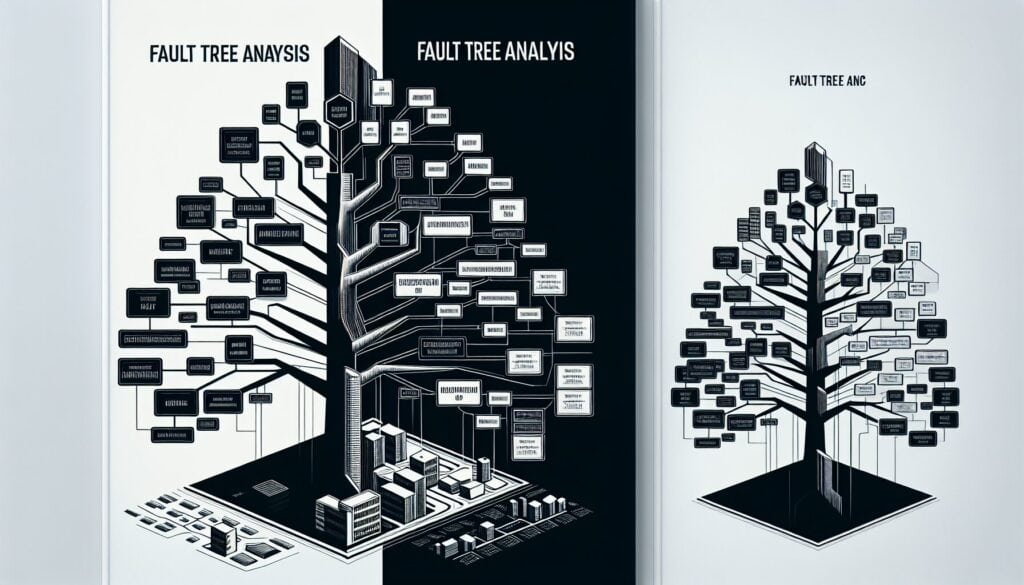A top-down, deductive failure analysis technique where an undesired state of a system (the “top event” or failure) is analyzed using Boolean logic to combine a series of lower-level eventos or failures that could cause it.
- Metodologías: Ingeniería, Calidad
Análisis del árbol de fallas (FTA)

Análisis del árbol de fallas (FTA)
- Análisis de fallos, Análisis del árbol de fallas (FTA), Mejora de procesos, Seguro de calidad, Gestión de calidad, Análisis de riesgos, Gestión de riesgos, Seguridad
Objetivo:
Cómo se utiliza:
- Starts with a specific system failure (top event). Then, all possible immediate causes (basic events or intermediate events) that could lead to this top event are identified and connected using logical gates (AND, OR, etc.) to form a tree structure. Probabilities can be assigned to basic events to calculate the probability of the top event.
Ventajas
- Provides a visual and systematic way to identify all potential causes of a system failure; Can be used for quantitative risk assessment if failure probabilities are known; Helps prioritize areas for improvement to enhance system reliability and safety.
Contras
- Can be complex and time-consuming for large systems; Requires detailed knowledge of the system and potential failure modes; Assumes events are independent unless explicitly modeled otherwise; Accuracy of quantitative results depends on the accuracy of input failure probabilities.
Categorías:
- Ingeniería, Fabricación, Diseño de producto, Calidad, Gestión de riesgos
Ideal para:
- Analyzing system safety and reliability by identifying all possible sequences of events that could lead to a specific undesired outcome (failure).
Fault Tree Analysis (FTA) is particularly advantageous in industries such as aerospace, automotive, nuclear power, and healthcare, where system reliability and safety are paramount. This methodology is effective during the design phase of a project, where engineers and designers can preemptively identify potential failure modes before they manifest in real-world applications. For example, in the aerospace sector, FTA can be employed to analyze the reliability of a flight control system, mapping out all possible failure pathways that could lead to a flight safety incident. In the automotive industry, manufacturers might utilize FTA when developing new vehicle models to ensure that all safety mechanisms are robust against potential failure scenarios. Participants in an FTA typically include system engineers, safety engineers, and reliability analysts, who collaboratively assess both hardware and software components of a system. It is often initiated by stakeholders seeking to improve operational safety and reduce risks associated with system failures. By quantifying the probabilities of basic events, FTA also enables organizations to allocate resources effectively, directing focus to the most significant risk factors that, if addressed, would yield substantial improvements in safety and reliability metrics. The visual representation of the fault tree further facilitates communication among multidisciplinary teams and supports decision-making processes by providing clear pathways that depict how various failures can converge to a top event. This structured approach aligns well with regulatory requirements in industries governed by strict safety standards, ultimately leading to enhanced compliance with safety protocols.
Pasos clave de esta metodología
- Define the top event representing the system failure.
- Identify immediate causes that could lead to the top event.
- Develop intermediate events that contribute to the immediate causes.
- Connect events using logical gates (AND, OR) to illustrate relationships.
- Assign probabilities to basic events where possible.
- Calculate the probability of the top event using the probabilities of basic events.
- Review and refine the fault tree for completeness and accuracy.
Consejos profesionales
- Incorporate Failure Mode Effects Analysis (FMEA) with FTA for a comprehensive understanding of failure modes and their effects on system performance.
- Use sensitivity analysis on the probabilities assigned to basic events to identify which events most significantly influence the probability of the top event.
- Regularly update the fault tree as system designs evolve or as operational data becomes available to ensure relevance and accuracy in risk assessments.
Leer y comparar varias metodologías, recomendamos el
> Amplio repositorio de metodologías <
junto con otras más de 400 metodologías.
Sus comentarios sobre esta metodología o información adicional son bienvenidos en la dirección sección de comentarios ↓ , así como cualquier idea o enlace relacionado con la ingeniería.
Contexto histórico
1960
1960
1960
1962
1970
1972
1980
1960
1960
1960
1960
1963
1970
1980
1980
(si se desconoce la fecha o no es relevante, por ejemplo "mecánica de fluidos", se ofrece una estimación redondeada de su notable aparición)















Publicaciones relacionadas
Gestión de operaciones de fabricación (MOM)
Sistema de Ejecución de Fabricación (MES)
Plan de control de la fabricación
Pruebas manuales
Tablas de evaluación de la manipulación manual (MAC)
ManTRA (Herramienta de evaluación de riesgos en las tareas manuales)